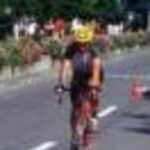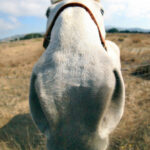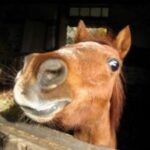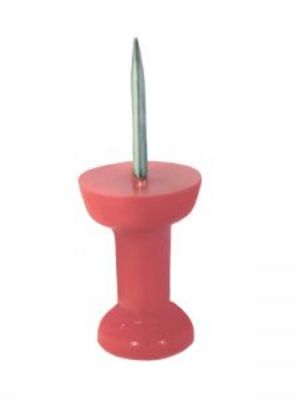If you have a young or older horse that has only been ridden in the arena, and you would like to go out on the trails; consider designing your own trail obstacle course. Practicing trail obstacles at home or at a friend’s will mentally prepare your horse for new and frightening situations on the trail.
An obstacle course can be set up on your own acreage or can be a group project shared by several. One person could contribute the place, and the others could share in the expense of constructing the obstacles.
When designing your obstacle course consider first the safety of you and your horse. Wear a riding helmet when participating in training exercises, and sturdy appropriate foot wear to protect your toes. When constructing obstacles keep in mind you do not want sharp edges, projecting areas, or anything that could hook into bridle, saddle, halter, or stirrups. Think these issues out long before attempting your first training sessions with your horse.
Suggestions for your obstacle course are:
Water Crossing
Ribbon Curtain
Log Crossing
Debris Field
Tire Course
Bridge
Barrels
Water Crossing
Materials needed are landscaping timbers, heavy duty plastic, gravel or sand, a shovel, or machinery to removal of the soil. If space and acreage allow, a natural flat water crossing is ideal for the purpose of training your horse for water crossings. Since we do not live in an ideal world constructing a water crossing obstacle is the next best thing for preparing your horse. Dig out an eight to twelve inch deep depression in the ground, about eight feet long and six feet wide. Put extra heavy duty plastic sheeting in the bottom of the depression, bringing the plastic up the sides. Frame the outer edges with landscaping timbers that are level to the top edge of the ground. Line the bottom with at least four inches of packed smooth stones, sand, or crushed small stone. Place stacked straw bales or plastic barrels on the ends to create a visual barrier to keep the horse from wanting to run around the obstacle. Fill with a garden hose, or wait for rain to naturally fill the water crossing. You may want to treat the water with something to inhibit mosquito growth during warm weather months.
Purpose of the water crossing obstacle is to prepare your horse for water crossings on the trail.
Ribbon Ride Through Curtain
Materials needed include two smooth twelve pressure treated or cedar poles, one bag of ready mix concrete, heavy clear plastic sheeting, a heavy duty stapler, and roll of duct tape. 9 foot of clothesline wire, two large eye screws. Attach one eye screw into the center of the top of each pole. Set the two poles eight or more feet apart, at least 36 inches into the ground and anchor them using the mixed concrete. Allow these to set overnight. Cut a twelve foot by eight foot sheet of heavy clear plastic. Fold in half so that you have the eight foot as the width, and six feet that is double. On the folded edge create a four inch pocket by stapling a line across the top spacing the staples at 3 inch intervals. Run duct tape over the line of staples and over the top edge of the curtain pocket. Using sharp scissors cut from bottom to eight inches from the top in long ribbons. Next put the clothes line wire through the pocket and attach to the first post by wrapping the wire end around the eye screw. Pull the wire very tight and run through the second eye screw, twisting firmly. Trim off excess wire, or coil over pole top.
Purpose of the ribbon ride through curtain is to prepare the horse for having to push through light brush and desensitize for the feeling of claustrophobia that affects some horses.
Log Crossing
Materials needed for obstacle include large and small logs that have been trimmed of any sharp points or jagged edges, chain saw or other cutting tools for shaping logs if necessary. To construct your log crossing just lay them out at random, elevating some to 18-20 inches, others lay on the ground, position some in L patterns creating a visual road for backing up, side passing, or maneuvering the horse.
Purpose of the log crossing obstacle is to teach the horse control when going over, and around logs you might find out on the trail.
Debris Field
Materials for the debris field include four landscaping timbers, laundry detergent bottles, soda or beer cans, plastic milk jugs, or any item that won’t blow across your training area, and will not injure the horse if stepped on. Using your four timbers build a square that lies flat on the ground. Fill the frame with the suggested debris.
Purpose of the debris field is to train the horse to see and step around odd things that might occur out on the trail.
Tire Course
Supplies needed are six old tires with the rims removed. Check to make sure no sharp metal is coming through the rubber. Lay out the tires in a pattern, fill with dirt, and pack tightly leaving no room for a hoof or horse shoe to catch on the edge of the tires.
Purpose of the tire course is to perfect the horse’s steering through walking, trotting, and backing a pattern through the tires and controlling the horse’s feet by having the horse step up onto the packed dirt on cue. Controlling your horse’s movements will help the rider and horse to move safely on tight areas of an actual trail.
Bridge
Materials needed include two 4 inch by 8 foot landscaping timbers, heavy exterior plywood, and two twelve foot pressure treated 2×4’s. Space the timbers three foot apart. Using pieces of 2×4 pressure treated cut eight three foot center braces. Attach one brace to each end, and then use the rest of the braces down the center to make it look like a ladder. Cut heavy duty exterior plywood to size of frame and attach using flat screws. Be sure to smooth out any rough edges. Bridge should be used on flat ground where it will not tip or actually span anything.
Purpose of the bridge is to teach your horse to cross on wood that makes a sound, and to stay on track on the narrow bridge without stepping off. Situations will arise on the trail when the horse must be willing to trust the rider and go where the rider needs them to go in tight or unsafe areas. The bridge can also be used to teach stepping up, and stepping off which will benefit with trailer loading.
Barrels
The materials needed for the barrels are just the barrels themselves 3-6 depending on your needs. Use the large 50 gallon plastic barrels. They are safer than metal, and will tip if you bump them too hard.
Purpose of the barrels is to teach control of the horse at varying speeds. Set the barrels up and create your own patterns, walking, trotting, or cantering your horse, and changing the patterns regularly. This exercise will assist you in controlling your horse at various gaits.
These obstacles are just a few of the fun things you can set up at home, in a paddock or arena, or out on your own farm. Use your imagination to create other training obstacles. Have a fun day on the course with friends to see whose horse has best mastered the obstacle course. You will have many fun training sessions with your horse. Remember to practice and master all obstacles working from the ground with a safe horse, prior to trying them under saddle. If the horse panics on lead, he will also panics under saddle. Remember safety is foremost the most important thing for you and your horse. If you feel unsafe in any situation consult a professional horse trainer for assistance.








